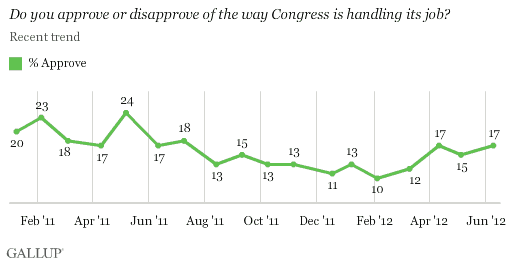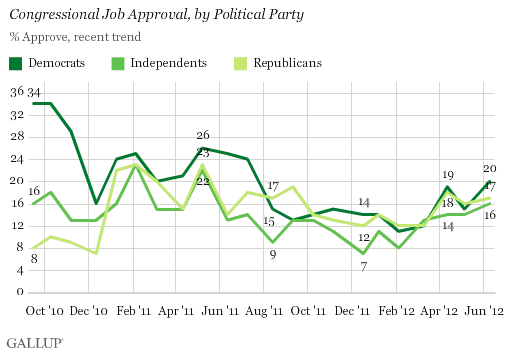PRINCETON, NJ -- Americans' approval of Congress is at 17% in June, similar to the 15% in May, and continuing the generally low levels seen since last June.

Congress' latest job approval reading, based on Gallup interviewing conducted June 7-10, is modestly higher than the all-time low of 10% recorded in February. Similarly, disapproval of Congress, now at 79%, is the same as in May, and not far below the record-low 86% recorded in February, and in December 2011.
Congressional job approval has generally been low for years, with readings as low as 18% in the summer of 2007 and 14% in July 2008. It did improve in 2009, as Barack Obama entered his initial "honeymoon" phase as president, with his own job approval ratings in the 60% range. In March 2009, Congress' job approval reached 39%, the highest it had been since February 2005. But that period of relative positivity did not last, and in 2010, 2011, and so far this year, Congress' approval ratings have routinely been below 20%. Approval of Congress has averaged 14% so far in 2012.
Congress faces many highly significant issues this year, focusing mainly on the "fiscal cliff" that will force major cuts in defense and entitlement spending in January, and the pending elimination of all of the Bush tax cuts if no action is taken by the end of the year. Given that this is an election year, it is probable that Congress will wait until after Nov. 6 to take real action on any of these concerns, lowering the chances that Americans' ratings of Congress will go significantly higher in the interim.
Congress approval remains generally similar across party lines, with 20% of Democrats approving, compared with 16% of independents and 17% of Republicans. This relative parity in approval reflects the currently divided nature of Congress, with the Democrats controlling the Senate, and Republicans, the House. When one party controls both houses, those who identify with that party are generally significantly more positive than those who identify with the other party.

Implications
Congress approval remains slightly higher than its all-time low of 10% recorded in February, but at 17% is certainly at the low end of its historical distribution. Given the divided nature of Congress, it is not clear how voters will take out their disappointment in Congress on their elected representatives on Election Day. Approval is slightly lower now than it was just before the 2010 congressional elections, in which Americans sent many incumbents home and flipped control of the House from the Democrats to the Republicans.
President Obama recently criticized Congress for not passing his jobs bill, which suggests that he and his campaign team have decided to use Congress as a foil to displace voter blame for the bad economy and employment situation. This, along with the probability that Congress will not take any meaningful actions before the elections, likely ensures that congressional job approval will remain in the current low territory in the months ahead.
Regardless, few would argue that it is an optimal state of affairs when about eight in 10 Americans disapprove of the way their elected representatives are handling their jobs.
Survey Methods
Results for this Gallup poll are based on telephone interviews conducted June 7-10, 2012, with a random sample of 1,004 adults, aged 18 and older, living in all 50 U.S. states and the District of Columbia.
For results based on the total sample of national adults, one can say with 95% confidence that the maximum margin of sampling error is ±4 percentage points.
Interviews are conducted with respondents on landline telephones and cellular phones, with interviews conducted in Spanish for respondents who are primarily Spanish-speaking. Each sample includes a minimum quota of 400 cell phone respondents and 600 landline respondents per 1,000 national adults, with additional minimum quotas among landline respondents by region. Landline telephone numbers are chosen at random among listed telephone numbers. Cell phone numbers are selected using random-digit-dial methods. Landline respondents are chosen at random within each household on the basis of which member had the most recent birthday.
Samples are weighted by gender, age, race, Hispanic ethnicity, education, region, adults in the household, and phone status (cell phone only/landline only/both, cell phone mostly, and having an unlisted landline number). Demographic weighting targets are based on the March 2011 Current Population Survey figures for the aged 18 and older non-institutionalized population living in U.S. telephone households. All reported margins of sampling error include the computed design effects for weighting and sample design.
In addition to sampling error, question wording and practical difficulties in conducting surveys can introduce error or bias into the findings of public opinion polls.
View methodology, full question results, and trend data.
For more details on Gallup's polling methodology, visit www.gallup.com.
